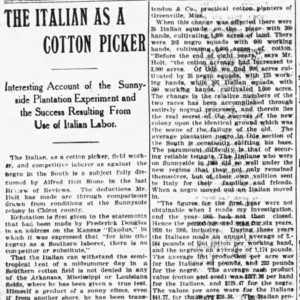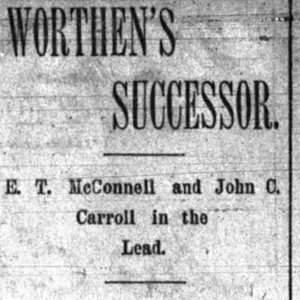calsfoundation@cals.org
Sunnyside Plantation
Sunnyside Plantation of Chicot County is synonymous with the immigration of Italian Catholics into the cotton fields of the Arkansas Delta. During the 1890s and early 1900s, Sunnyside Plantation was the largest Catholic colony of new immigrants in the state and the primary factor in attracting Italians to Arkansas. Almost all Italians had left by 1910, however, due to dissatisfaction with increasing poor working arrangements.
In the later half of the nineteenth century, Austin Corbin of New York bought more than 10,000 acres of Chicot County land on the Mississippi River and established his Sunnyside Plantation. Under the auspices of the Sunnyside Company, Corbin consolidated several plantations and named the property after an area plantation that dated back to the 1830s. When difficulties arose in finding laborers to work these cotton fields, including a stint with convict labor, Corbin made an arrangement with Prince Ruspoli, mayor of Rome, for Italian immigrants to farm the property. Ruspoli and Corbin arranged for the immigration of 100 Italian families annually for five consecutive years. Corbin provided these Italian immigrants with twelve and a half acres of land with housing. The land and houses “were payable over twenty-one years at an annual interest rate of 5 percent of the unpaid balance.” These terms were appealing to potential immigrants. Italy’s economy was then doing poorly, in part from the government’s rush to industrialize rural sectors of the country.
The first party of over 500 Italian Catholics reached Sunnyside Plantation in December 1895, and a similar number reached Chicot County in January 1897. Though the colony was able to build a school, church, and railroad connecting the various portions of the plantation, the Italian immigrants experienced many problems at Sunnyside. They were not accustomed to growing cotton and did not have the tools to do so. One firsthand account states that the Italians who immigrated to the plantation were not farmers at all but rather from “an assortment of occupations and trades.” Italians from different regions of their motherland experienced difficulties working together. Floods and malaria plagued the colony. Corbin died in 1896, and the colony was left in disarray. By 1898, a new business, O. B. Crittenden and Company, had taken over the plantation with contract conditions far less favorable than the agreement with Corbin.
For these reasons, many of Sunnyside’s Italian Catholic immigrants left for other locations. Various accounts report that the Italians returned to Italy; moved to nearby plantations in Arkansas, Mississippi, and Alabama; or even moved to Brazil. In 1898, many followed Father Pietro Bandini to Tontitown (Washington County). Bandini, who had resigned from his position as the secretary of the Society for the Protection of Italian Immigrants in New York to serve as a chaplain for these Italian families in Arkansas, experienced the difficult life at the Sunnyside Plantation and searched for a more desirable location for his countrymen. After finding a suitable area in the Ozark Mountains in the northwest part of the state, Bandini led nearly half of the colony to Tontitown. Bandini’s new colony cared for the orphans of the Sunnyside Plantation. Some forty families also opted to leave the plantation, and they founded the town of Rosati near Knobview, Missouri.
Nearly thirty-five families remained at Sunnyside Plantation during the late 1890s. One first-hand account states that the Italians present on the plantation in 1898 “did so well under the new regime that they not only remained themselves, but of their own volition sent to Italy for their families and friends.” More workers did arrive in the following years, although they were reportedly recruited in Italy under deceptive practices and worked under unfair labor practices (for instance, going more deeply into debt all the time by being forced to shop with scrip at the company store and pay interest on the constantly mounting debt). In 1907, the United States Department of Justice investigated Sunnyside and issued a report charging O. B. Crittenden and Company with breaking debt peonage laws. Investigator Mary Grace Quackenbos had found evidence of peonage at Sunnyside, but the influence that powerful Mississippian LeRoy Percy, who had leased the plantation, held with Congress and President Theodore Roosevelt resulted in her report being buried in the federal bureaucracy and no action being taken.
Almost all Italian workers left the plantation by 1910 after the company changed policies and placed the Italian Catholics in a sharecropping arrangement. After World War II, the Sunnyside Plantation was divided and sold as smaller farms. Only a few families who trace their ancestors to Sunnyside Plantation remain in the surrounding area.
For additional information:
Braun, Lauren Hillary. “Italians, the Labor Problem, and the Project of Agricultural Colonization in the New South, 1884–1934.” PhD diss., University of Illinois at Chicago, 2010.
Braun-Strumfels, Lauren. Partners in Gatekeeping: How Italy Shaped U.S. Immigration Policy over Ten Pivotal Years, 1891–1901. Athens: University of Georgia Press, 2023.
Hadley, A. W. “The Tontitown Settlement: History of a Successful Italian Colony in Arkansas.” Maxwell’s Talisman, October 1905, 14–16.
Ricca, Brad. “When Italians Were Tricked into Debt Peonage in the South.” Washington Post, September 25, 2022. https://www.washingtonpost.com/history/2022/09/25/italians-sunnyside-debt-peonage/ (accessed September 26, 2022).
Roselli, Bruno. “An Arkansas Epic.” Century Magazine, January 1920, 377–386.
Stone, Alfred H. Italian Cotton-Growers in Arkansas. New York: Review of Reviews Company, 1907.
Whayne, Jeannie M., ed. Shadows over Sunnyside: An Arkansas Plantation in Transition, 1830–1945. Fayetteville: University of Arkansas Press, 1993.
Woods, James M. Mission and Memory: A History of the Catholic Church in Arkansas. Little Rock: August House, 1993.
Jamie Metrailer
University of Arkansas at Little Rock
 Sunnyside Plantation Article
Sunnyside Plantation Article  Sunnyside Plantation Convict Labor Article
Sunnyside Plantation Convict Labor Article 




My grandfather was [an indentured laborer] from Italy and came to Lake Village, Arkansas, at Sunnyside Plantation.
As a descendent of a Sunnyside survivor, I was told that the conditions on the plantations were incredibly poor. Most of the Italians were from northern Italy and were not used to the heat of the American south. It was said that the people were dying like flies from malaria, snake bites, and the living conditions. They were moved to areas more like the area they came from in Italy, the mountains. These Italians were industrious and made their crops. The Italians were put in a position of owing the company store! They were basically indentured slaves (my opinion). The priest came to Sunnyside and worked out a way to remove them from the plantation.
The people of this area had no respect for the Italians. They have plowed most of the cemetery under, with bones occasionally showing up in the slough that surrounds it. There are very few stones left, and an area has been fenced off that is much smaller than the original cemetery.